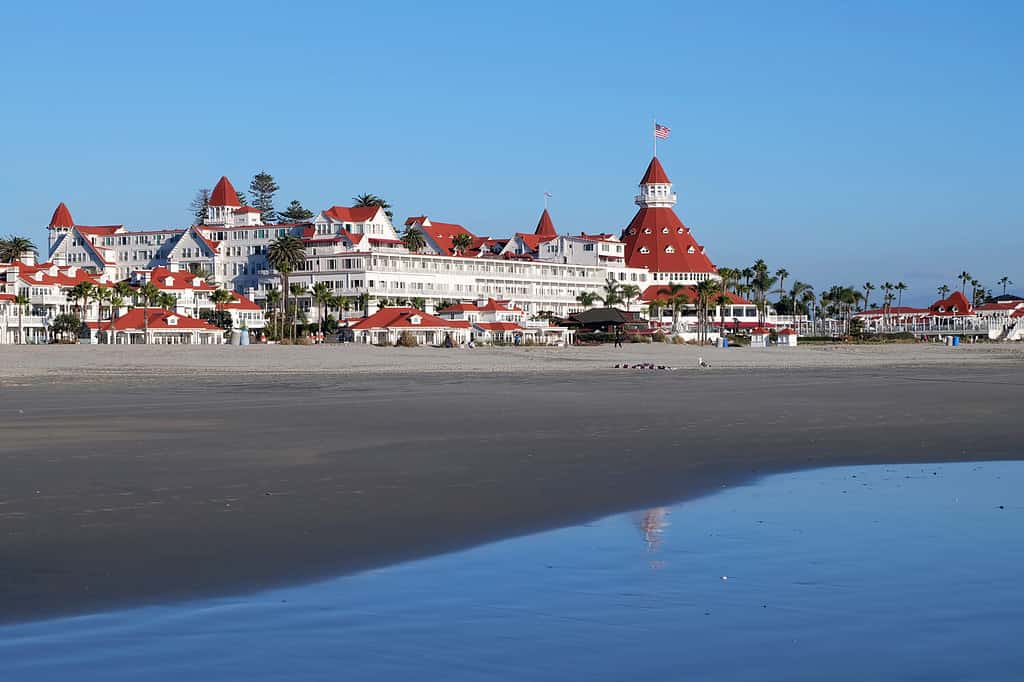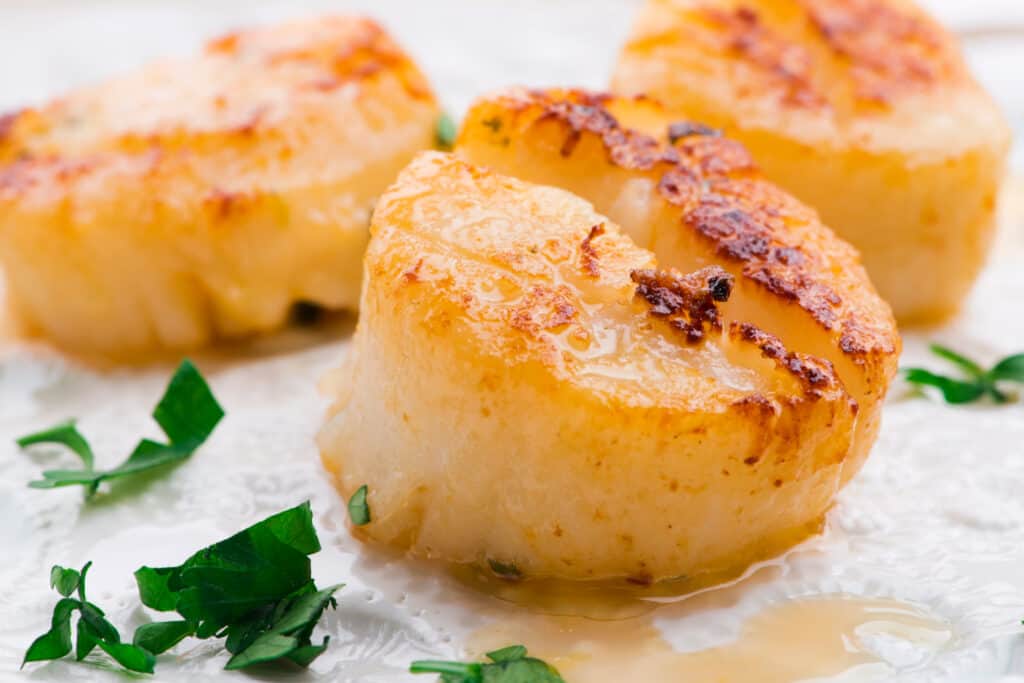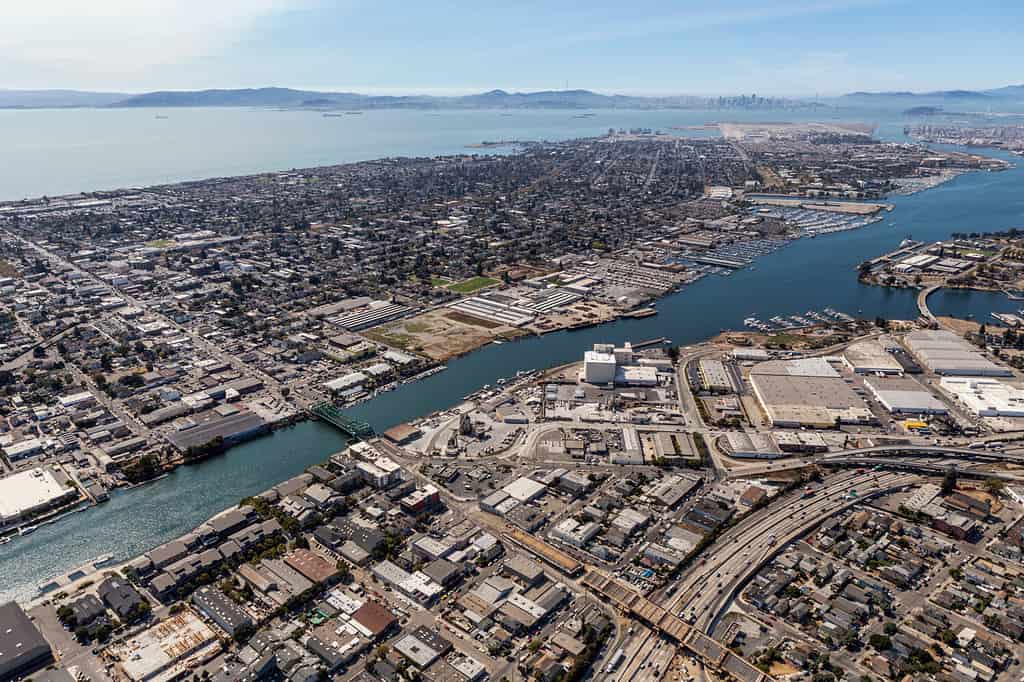California, the “Golden State,” is one of the top destinations for travelers. It’s one of the few places where five major climate types lie in close proximity to each other. The diversity doesn’t stop with California’s climate, however. Topography and natural beauty supply an abundance of spectacular areas to visit.
Mountainous Northern California offers more rugged and mountainous terrain, and that includes its islands. Let’s discover the five must-visit islands off the northern California coast!
1. Coronado

Coronado Island sits right across the bay from San Francisco.
©emerge/Shutterstock.com
Just across the bridge from San Francisco, visitors know Coronado (Spanish for “crowned”) for its pristine wide beaches, old-world mansions, and charming shops and restaurants. Actually a tied island, Coronado is connected to the mainland by a tombolo, which is a sandy isthmus.
Incorporated in 1890, the island’s purchasers promoted Coronado as a resort community. In 1888, businessmen built the iconic Hotel Coronado, cementing the island’s identity as an upscale retreat.
Presidents, celebrities, socialites, and dignitaries have visited this National Historical Landmark. L. Frank Baum spent many winters in this spectacular haven and its aesthetics may have been the inspiration for the Emerald City in “The Wizard of Oz.”
With 32.7 square miles (and 7.9 square miles of land), Coronado enjoys a semi-arid climate. You can access the island via the Sandiego-Coronado Bridge. The bridge opened in 1969 and provides quicker entrance than ferries or State Route 75, which were previously used.
The U.S. Navy still operates Naval Air Station North Island on Coronado. On the southern side of the town is Naval Amphibious Base Coronado. The Base is a training facility for the Navy SEALs and Special warfare combatant-craft crewmen (SWCC).
What to Do
What do you do once you get to Coronado Island? The island is easily walkable or sightseeable via bicycle tour. The 10-mile Coronado Cruise Bike Tour lets you explore the island and its historic and charming sights. Some of these include the Coronado Bridge, the Hotel Coronado, and various charming shops and restaurants.
Rent a kayak or paddleboard to explore the island from the water and explore such area sites as the USS Midway, Naval Station Island, Petco Park, the Embarcadero, and the Silver Strand. Learn about the spectacular area trees in Spreckles Park, or hop on a segue to explore on your own or with a guide.
The obvious choice for a relaxing day in California is to check out one of the immaculate beaches. Coronado Central Beach is a favorite. The island also offers four additional coastline havens. These include Glorietta Gay Beach, Coronado Dog Beach, Silver Strand State Beach, and the Ferry Landing Marketplace.
After relaxing at the beach, spend some time at one of the island’s parks. The first ferry from San Diego landed in Centennial Park. Other parks include Star Park, Bayview Park, and Tidelands Park. For more history, visit some of the island’s historical homes. The Mann House, L. Frank Baum House, and Old City Hall all offer unique experiences.
Where to Stay

Victorian Hotel del Coronado’s red-and-white exterior marks it as a Coronado paradigm.
©edithpifpaf/Shutterstock.com
What accommodations does Coronado Island offer? The aforementioned iconic Hotel del Coronado is the island’s landmark. The red-and-white spirals showcase this luxurious resort that treats its guests like royalty. Old blends with the new, as the brass cage elevator and Victorian chandeliers lie among the lighter woods and accents that highlight the resort’s renovation. Room options abound. Choose from the original main building, the modern Ocean Towers, the seaside California Cabanas, and the sumptuous villas of Beach Village.
Other great accommodations include the Glorietta Bay Inn, with its Italian Renaissance architecture, and the Spanish-style El Cordova Hotel. Additionally, the 1906 Lodge and Coronado Mariott Resort and Spa offer luxurious yet affordable accommodations.
Of course, the island offers ample shopping choices. On Orange Avenue, visit the boutique Adorn, Crown Meets Sea, and Arts and Frames by Wood Gallery, among others. Ferry’s Landing shops include the European Vom Fass, Miss Match, and the Coronado Farmer’s Market. El Cordova Plaza showcases The Galleria, The Domini Salon of Beauty and Wellness, and Treasures from the Heart.
Where to Eat

Coronado features an abundance of fresh seafood such as these pan-seared scallops.
©joanna wnuk/Shutterstock.com
Probably the most important question any visitor has is, “Where should I eat?” Coronado definitely has its share of fine cuisine. Located in the Hotel de Coronado, Serẽa Coastal Cuisine boasts fresh seafood headed by San Diego’s own Chef Jose “Jojo” Ruiz. Choices include Halibut ceviche, wood-grilled whole bone whole fish deboned tableside, pan-roasted bay salmon, and seafood “Romescada,” a delectable mixture of Pacific halibut, Hokkaido scallops, Baja shrimp, and romesco sauce.
Another top choice is Peohe’s in Ferry Landing. Peohe’s features a spectacular waterfront view. Enjoy the view while you dine on Chilean sea bass pinot noir, shrimp and artichoke linguine, and shrimp, avocado, and mango stack. The Henry on Orange Avenue features California fare with a lighter twist. Enjoy unami Brussels sprouts, heirloom tomato, and grilled halloumi salad, or lobster and black truffle tagliatelle.
For something a little different, try Clayton’s Coffee Shop, an island staple since 1938. Owner Mary Frese hails from Tennessee and has added some southern charm to Clayton’s options. Frese offers chicken fried steak and eggs, Mary’s toad in the road with country gravy, and corned beef hash benedict all delight.
Another enticing option is MooTime Creamery, where the made-from-scratch ice cream is made from only the freshest ingredients. Try the Mississippi mud sundae or the mango moomania smoothie for a refreshing treat.
2. Alcatraz

Alcatraz Island is a formidable force in the San Francisco Bay.
©f11photo/Shutterstock.com
Another island in Northern California to visit is Alcatraz. If the mention of Alcatraz makes you think of Clint Eastwood attempting to escape this fortress or Sean Connery attempting to break into it, you’re not alone. Also known as “The Rock,” Alcatraz enjoys a rich history in northern California.
Located just 1.25 miles offshore from San Francisco, Alcatraz is a small island with an area of only 22 acres. When Lieutenant Juan Manuel de Ayala explored the desolate island in 1775, he gave it the moniker Isla de los Alcatraces, which means “Isle of the Pelicans.”
Much later in 1846, Military Governor of California John C. Fremont bought the island for the U.S. government from Francis Temple for $5,000.00. In 1848, the U.S. government began studying the island for its possibility as a military point to protect enemy approaches to the San Francisco Bay.
In 1858, Fort Alcatraz’s first garrison consisted of around 200 soldiers. By the time of the Civil War, the government used Alcatraz for various military purposes. Some of these were storing firearms to deter them from falling into the hands of Confederate sympathizers.
Alcatraz Repurposed
The government began housing accused criminals in Alcatraz as early as 1859 because it is surrounded by frigid, powerful currents. In 1867, officials built a brick jailhouse. Construction on the enormous concrete cell block — Alcatraz’s most dominant feature — began in 1909.
The government established Alcatraz as a federal prison in 1934 as a destination for prisoners who had caused trouble and/or attempted to escape other prisons. In the 29 years it operated as a prison facility, Alcatraz housed many notorious criminals. Some of these were Al Capone, Robert Franklin Stroud, and George “Machine Gun” Kelley.
After the government closed the prison in 1963, in 1964, a group of Native Americans claimed the island as a legality from a treaty giving them rights to claim “unoccupied government land.” Tumult over the property progressed until 1972 when the U.S. National Park Service purchased it as a part of what became the Golden Gate National Recreation Area.
Visiting Alcatraz
How do you go about visiting this famous northern California island? Many San Francisco Bay cruise tours will take you around the island, but the only way to actually visit it is through one of the ferries operated by City Experiences. The boats depart from Pier 33, also called Alcatraz Landing.
City Experience offers three different tours for you to experience the Alcatraz encounter. The first is the Day Tour. This tour lasts several hours and includes a roundtrip ferry and a self-guided walking tour on the grounds and within the main cell house. You’ll also have access to the New Industries Building. This includes an exhibit recognizing the 50th anniversary of the Influential Occupation of Alcatraz by Indians of All Tribes. Traverse the audio tour “Doing Time: The Alcatraz Cellhouse Tour” as well as the exhibit “The Big Lockup: Mass Incarceration in the United States.”
To experience a bit more of Alcatraz’s ominous mood, choose a night tour, which lasts 2 ½ hours. In addition to the daytime exhibits and tours, you’ll get to take in the spectacular sunsets over the San Francisco Bay. Finally, in a group of 30 or fewer, you can try the Behind the Scenes tour discovering areas not otherwise available to the public.
As far as food, Alcatraz only permits eating, drinking, and smoking on the dock. Once you step onto the island, you may only have bottled water in a non-glass container. Availability of food is limited. You can buy snacks at the Golden Gate National Parks Conservancy bookstores and on your ferry trips to the island and back.
3. Angel

Enjoy the calm shores along Angel Island’s coastline.
©Bill Florence/Shutterstock.com
Angel Island, the second-largest island in the San Francisco Bay, is wholly situated within the Angel Island State Park. On a clear day, you can see Sonoma and Napa from the north side of the island and San Jose from the south side. Mount Livermore, the highest island peak at 788 feet, sits at the center of the island.
Two thousand years ago, the island was a Native American settlement. In the 1800s, inhabitants used it for cattle ranching. As with most islands in the area, Angel Island also played a prominent military factor in the Civil War, the Spanish-American War, and both of the World Wars.
The government used the island as a quarantine station in the late 1800s due to the perilous threat of the bubonic plague. It is known as the “Ellis Island of the West” because from 1910 to 1940, it was used as an immigration station. Asian immigrants seeking refuge had to be inspected and at times detained.
Angel Island became a state park in 1955, showcasing its plant communities of coastal grassland and scrub. Animals on the island included the Angel Island mole, a subspecies of the broad-footed mole. Mule deer, introduced in 1915 for hunting, overpopulated the island due to a lack of predators.
What to Do
How should you go about visiting Angel Island? Take an early ferry and visit the immigration station first, where you can take one-hour tours of the station and its barracks. Next, head up the moderate North Ridge Trail, where you can relish a 360-degree view of the bay. There is also a bicycle trail where you can bring your own bike to ride or rent one by the hour or for the entire day. The park service also provides camping sites, picnic tables, and day-use boat docks for those wanting to spend a little more time on Angel Island.
What about food? Unfortunately, the Angel Island Cafe closed due to the early 2023 storm surges. However, they still offer small pre-packaged snacks, water, drinks, beer, wine, and other small items every day while supplies last.
4. Alameda

Alameda got its name from the Spanish word for “grove of poplar trees” or “tree-lined avenue.”
©trekandshoot/Shutterstock.com
Located in the San Francisco Bay, Alameda Island is adjacent to Oakland. The island measures six miles long and a mile wide and houses most of the city of Alameda. The island was once a peninsula but was separated from the mainland in the early 20th century. The south side of the island features several beaches and is mostly all developed now, with numerous Victorian homes built in the late 1800s and early 1900s.
What to Do
Join the “2nd Friday Art Walk,” which has been operational for a decade. The walk showcases both art galleries and businesses in downtown Alameda and Jingletown in nearby Oakland every second Friday of the month.
For a history brief, visit the Alameda Museum, which was established in 1951. The museum houses artifacts and historical documents of the area and is open to the public except on holidays. Alameda’s climate is perfect for a day at Crown Memorial State Beach, which features spectacular views of the San Francisco Bay and is a favorite of kite surfers.
Where to Stay
Lodging opportunities abound. Coral Reef Inn & Suites offers private suites and relaxing poolside moments at their private accommodations. Other great choices include Hampton Inn & Suites, Hawthorn Suites, and the Marina Village Inn.
Where to Eat
After a day at the beach or filled with walking tours, your appetite is sure to be piqued! Saltbreaker offers diverse fare such as smoked trout rillette, deviled eggs, and steak frites. For a change of pace, try Bahn Mae Vane for modern Lao and Thai food. Specialties here include sakoo and fresh Lao spring rolls.
5. Farallon

The Farallon Islands offer a unique experience for viewing wildlife.
©iStock.com/LouieBaxter
Only 26 miles off the coast of San Francisco, the Farallon Islands are somewhat of a mysterious wonder. They are a group of four islands in the Gulf of the Farallones and are sometimes known as the “Devil’s Teeth Islands” due to their perilous and jagged underwater shoals. English explorer Sir Francis Drake was the first person to have recorded visiting the islands in 1579, naming them the “Islands of St. James.” Spanish explorer Sebastian Vizcaino coined the islands’ permanent name of Farallones (literally Spanish for “cliffs”), however, in 1603.
Storied Past
Many find additional history of the islands interesting, such as their possible connections with the schooner Malahat, which was known as the “Queen of the Rum Row” between 1920 and 1923. The ship was known to have run more contraband liquor during prohibition than any other vessel.
The islands were also used as a radioactive waste dump from 1946 to 1970, with 47,500 containers being dumped. Most of the radiation, however, had already decayed by 1980. In 1981, Congress designated the area as a protected sanctuary, and today, the islands are a sanctuary run by the Farallon Islands National Wildlife Refuge.
San Francisco locals gauge how clear a day it’s going to be by how visible the Farallon Islands are. Often obscured by dense fog, even on the clearest day, the islands loom as an ominous blur on the horizon. The waters are infamously dangerous: Native Americans called them “the islands of the dead.” In April 2012, a yacht competing in the annual Full Crew Farallones Race crashed onto Farallon’s rocks and capsized. Only three of the eight onboard survived.
In fact, because the islands are part of the National Wildlife Refuge, the state considers them a protected sanctuary. Only researchers and scientists can access them; the public is prohibited. Even the researchers get to the island by transitioning from a larger to a smaller boat that is then lifted over the steep, rocky terrain by a crane.
Why Visit
So, if the Farallons are so treacherous and normal citizens can’t even visit, why are they a must-see northern California island? From May through November, the Oceanic Society gives full-day guided cruises around the island. Nature specialists add commentary and help point out the myriad of wildlife in the area.
What kinds of wildlife exist on Farallon? On the Oceanic Society’s whale-watching trips, you can see gray, humpback, and blue whales. Additionally, orcas occasionally appear. Throughout the entire year, pods of porpoises, dolphins, sea lions, and seals abound in the area. Great white sharks are also a huge attraction, as are seals and various seabirds. Even though many people who brave these dangerous waters say that they would probably not go back, they acknowledge that visiting this California island enigma is worth the experience.
The photo featured at the top of this post is © Carlos Gandiaga Photography/iStock via Getty Images
Thank you for reading! Have some feedback for us? Contact the AZ Animals editorial team.







